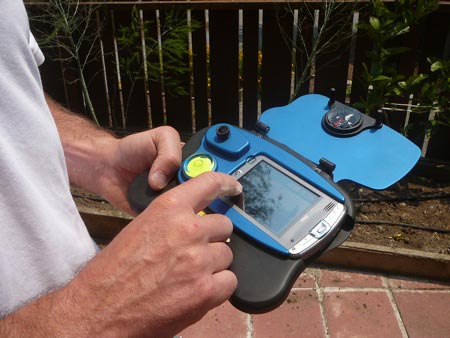Science
Explosions in the Lab
What can be learned from the death of a young biochemist at UCLA?
By Beryl Lieff Benderly
Posted Friday, May 22, 2009, at 7:03 AM ET
A few days after Christmas of 2008, a young technician in a biochemistry laboratory at the University of California-Los Angeles began to transfer a tablespoon of t-butyl lithium from one container to another. T-butyl lithium is pyrophoric, meaning it ignites on contact with air, but Sh! eri Sangji wasn't wearing a protective lab coat—instead, she had on a flammable synthetic sweatshirt. Somehow the stuff spilled onto her clothing, and she was engulfed in flames. Sangji died from her burns 18 days later, and UCLA officials bemoaned the "tragic accident" that killed her. According to a recently completed government investigation, the fire could have been foreseen. On May 4, the California Division of Occupational Safety and Health cited the university for multiple "serious"—i.e., potentially life-threatening—violations, including its inability to show that Sangji had been trained to handle the dangerous substance and the lack of proper protective attire. UCLA's own safety officials had already faulted the lab on the latter issue back in October, but the problem went uncorrected. All told, Cal/OSHA imposed $31,875 in fines, which! the university did not contest. The death of a healthy young woman from a chemical spill at a UCLA lab is deeply shocking. But the presence of flagrant safety violations at a major research university is no surprise. After reading about the Sangji incident and others like it, a columnist for the peer-reviewed journal Chemical Health and Safety wrote that he'd come to the "disheartening conclusion that most academic laboratories are unsafe venues for work or study." Though no one keeps comprehensive national statistics on laboratory safety incidents, James Kaufman, president of the Laboratory Safety Institute in Natick, Mass., estimates that accidents and injuries occur hundreds of times more frequently in academic labs than in industrial ones. A depressing litany of news items backs up these observations: In 2005, a biology professor at Cleveland Stat! e University was electrocuted when he plugged in a light using an ungrounded plug. That same year, an explosion in a Stanford University lab critically injured a postdoctoral researcher. In 2006, Tufts University was fined by the federal OSHA after two lab technicians were exposed to potentially lethal botulinum toxin when one opened a centrifuge prematurely. Also in 2006, a nitrogen cylinder that had been tampered with exploded, causing extensive damage to a Texas A&M building (PDF). In 2008, an explosion in a University of Rochester laser lab left one employee seriously injured. Why the difference! between industry and academe? For one thing, the occupational safety and health laws that protect workers in hazardous jobs apply only to employees, not to undergraduates, graduate students, or research fellows who receive stipends from outside funders. (As a technician, Sheri Sangji was getting wages and a W-2. If she'd been paying tuition instead, Cal/OSHA could not even have investigated her death.) Commercial firms, which have only employees, make workplace safety a top priority. In industry, a major incident can result in significant career damage and sometimes dismissal. The major scientific companies that do research comparable to that in university labs go so far as to make safety a line item on a lab chief's annual performance evaluation, so any significant safety violation becomes a permanent black mark. The safety of labs and their personnel thus becomes the personal responsibility of the lab chiefs and their superiors. Academe doesn't work that way. The ! major federal funding agencies, which set the priorities for research on campuses across the country, don't even ask about a scientist's safety record before awarding funds, and neither do tenure and promotion committees. At most colleges and universities, the responsibility for lab safety falls to an office of health and safety that has little power over professors who are bringing in millions of dollars in grants. Even serious mishaps rarely damage lab chiefs' careers. Academic culture tends to disdain the painstaking documentation of training and procedures in industrial labs, treating them as bureaucratic Mickey Mouse beneath the dignity of free-spirited investigators. Since what counts in academe is publishing papers and winning grants, any change will have to start with the people who control the research money. Federal funding agencies like the National Institutes of Health and the National Science Foundation should treat the welfare of the students, postdocs, and technicians who do the labor of American science with the same atte! ntion they afford experimental subjects and laboratory animals. As it stands, applicants are routinely asked to document the steps they will take to safeguard the people and vertebrate animals they'll be studying, but they needn't provide any information on how they'll protect the experimenters themselves. If the point of medical research is to save lives, then the NIH and NSF should insist—on pain of dismissal, like the chemical companies—that researchers follow all accepted safety procedures. If Sheri Sangji's death is to mean anything, it must be that no lab chief—and certainly no federal agency—claiming to further human welfare ever again tolerates the risk of harm to lab workers. That means that university administrators from the provost on down must make safety a serious concern and a requirement for career advancement and hiring, and tenure and promotion committees must h! old faculty members responsible for seeing that everyone in their labs has the training, skills, and equipment needed to work safely. Funding agencies must make a good safety record and evidence of safety awareness real conditions for getting and keeping grants. Never again should academic research needlessly claim the life of a researcher. Beryl Lieff Benderly is a Washington, D.C., science writer who writes the monthly "Taken for Granted" column on science policy and work force issues for the Web site of Science magazine.
Article URL: http://www.slate.com/id/2218825/ |
 Many a parent has ordered something off the kids' menu just to see their picky eater barely touch it. Why make dining out any pricier it already is? Go where the kids eat free!
Many a parent has ordered something off the kids' menu just to see their picky eater barely touch it. Why make dining out any pricier it already is? Go where the kids eat free! We've taken you down the path to
We've taken you down the path to  Buying the right sunscreen could mean the difference between a pleasant day at the beach and a nightmare of splotchy pain.
Buying the right sunscreen could mean the difference between a pleasant day at the beach and a nightmare of splotchy pain. 
 Savings.com has put together a list of 30 of the most followed people on Twitter who offer tips on good deals. Of course, savings.com readers have already started adding alternates in the comments below the list. Feel free to make your own suggestions after the jump.
Savings.com has put together a list of 30 of the most followed people on Twitter who offer tips on good deals. Of course, savings.com readers have already started adding alternates in the comments below the list. Feel free to make your own suggestions after the jump.



 Geoffrey Miller, an evolutionary psychologist at the University of New Mexico, says marketers are trying too hard to find a working model of why people spend money the way they do. It really comes down to the human equivalent of "
Geoffrey Miller, an evolutionary psychologist at the University of New Mexico, says marketers are trying too hard to find a working model of why people spend money the way they do. It really comes down to the human equivalent of " Listen parents, we told you all those years that cleaning the dishes before putting them in the dishwasher was silly and duplicative, and now we have the Times telling us we were right! Ha! Pre-rinsing dishes is "actually triple bad" according a "senior dishwasher design engineer," because dishwasher detergent exists to attack food, and when it doesn't find any, it instead attacks your glasses. It also wastes electricity and water. And that's not the only mistake most people make. Inside, the Times' tips for keeping your dishwasher happy...
Listen parents, we told you all those years that cleaning the dishes before putting them in the dishwasher was silly and duplicative, and now we have the Times telling us we were right! Ha! Pre-rinsing dishes is "actually triple bad" according a "senior dishwasher design engineer," because dishwasher detergent exists to attack food, and when it doesn't find any, it instead attacks your glasses. It also wastes electricity and water. And that's not the only mistake most people make. Inside, the Times' tips for keeping your dishwasher happy...